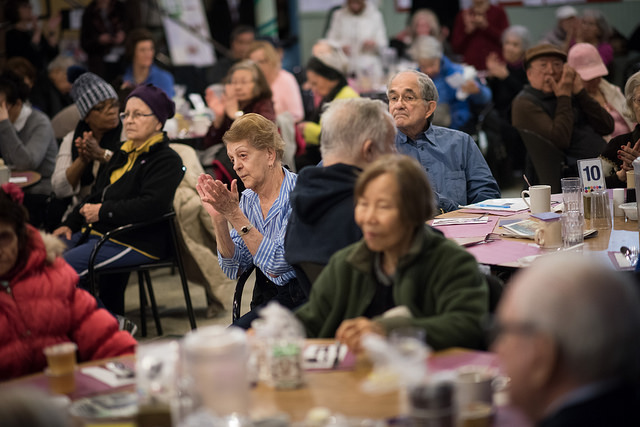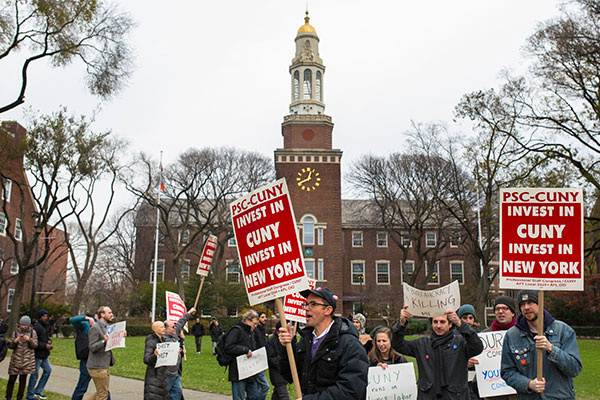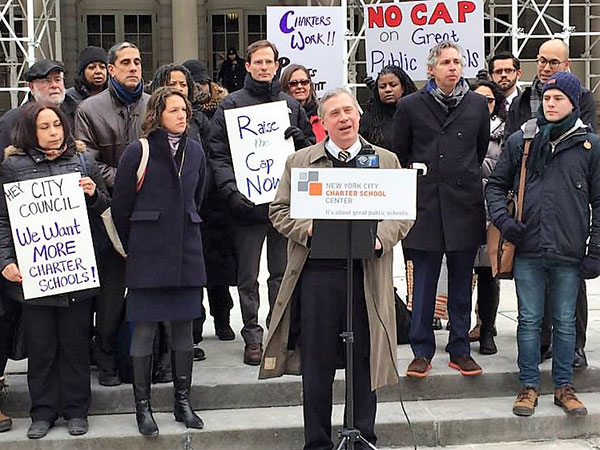The ‘Mansion Tax,’ a Smart Step Toward Fairness

Seniors (photo: Michael Appleton/Mayor's Office)
I grew up around some common stereotypes of New York City wealth: private schools, trust fund kids, and expensive Manhattan real estate. But as a New Yorker with family here going back to the late 1800s, I am aware that most of the people in our city do not have such luxuries. That’s why I support the “mansion tax” being championed by Mayor de Blasio and state Assembly Democrats and want to see it passed as part of the state budget in Albany this week.
Due to income inequality, gentrification, and inadequate Social Security benefits, among other factors, 19 percent of seniors in New York City live in poverty, according to City Limits. Seniors will constitute over a fifth of all New Yorkers in the next decade. Funds from the mansion tax, a 2.5% tax on sales of New York City property above $2 million, would go to rent subsidies for low-income seniors in New York City.
My family isn’t top 1% or even top 5% rich, but we have owned a large apartment on Riverside Drive since the early 1990s. If we sell and buy another apartment of similar value, we would pay the mansion tax, as would the buyer of our apartment. The people I grew up with -- those who can afford, or may inherit, homes worth over $2 million -- can afford to pay this tax. But taxes shouldn’t be levied simply because people can afford to pay them.
Because of the high costs of living in New York, many people with real estate worth over $2 million do not “feel” wealthy. Thankfully, taxes are about how wealthy you are, not how wealthy you feel. A better reason for taxes on wealth is that those with valuable property in our city have benefited from policies that have worked to purposefully increase our property values since the fiscal collapse of the mid 1970s. Taxes aren’t charity: we are returning to our city a portion of the success that we owe back to it -- and who better to benefit from this than seniors who don’t have a lot to live on? Local politics and policy have benefitted homeowners in New York City, while decades of national policies have left behind millions and hollowed out the middle class.
As economic historian Adam Tooze notes, “The fact that pre-tax incomes for the least favored half of American’s citizens have not risen, but have fallen slightly over the last forty years ought to be a show stopper. Literally, all other policy discourse should surely cease.” Read that again. The poorest half of the U.S. have experienced no real income gains in forty years. There are broad structural issues with our politics and economy that are driving stagnant incomes and the racial wealth gap. Addressing them requires transformational changes. The mansion tax is one small step in that direction that New York City can and should take, and will with approval in Albany.
Another point in this debate focuses on the hard work of the wealthy: that they have earned their accumulated benefits. This isn’t the full story. I was raised in a social environment that encouraged overwhelmingly white children to identify as “upper-middle class” rather than confront the realities of our wealth and class. Since then, I’ve been pushed to learn that hard work isn’t the only ingredient in my family’s prosperity. In addition to hard work of my forebears, the engine of 20th century prosperity was built on racialized social and economic policy that proactively furthered the opportunities and wealth of white families while systematically excluding families and communities of color. The result of these policies are now are often referred to as the racial wealth gap.
My family’s wealth serves to protect our comforts and privileges at the expense of our neighbors. This is precisely what opposing the mansion tax achieves: one real estate official called this tax “DOA” in Albany, while Manhattan Borough President Brewer and Governor Cuomo, both Democrats, oppose it. That’s their choice, but don’t do it on our account: not all of the wealthy want to raid the commons in order to keep more for ourselves. My family and many others like us support the mansion tax because we support New York City and know paying our fair share of taxes is necessary for its long-term vitality. This includes the safety and well-being of our seniors.
For a generation of young people who may inherit or be fortunate enough to purchase a house or apartment in New York City, issues like the mansion tax should not be an obscure policy matter declared DOA by the real estate lobby. New York City should do what it can to promote fairness and equity in our society, and Albany should agree. Wealthy people, especially young people with high incomes or inherited wealth need to push ourselves and each other to reframe the debate. Those with wealth, even the rich who do not “feel” rich, must pay more to keep New York City livable for everyone.
***
Evan Casper-Futterman is a PhD Candidate in Urban Planning and Public Policy at Rutgers University and is an adjunct instructor at several CUNY campuses. He is a member of Resource Generation, a national membership-based organization that organizes young people with wealth for the equitable distribution of wealth, land, and power.
***
Have an op-ed idea or submission for Gotham Gazette? Email This email address is being protected from spambots. You need JavaScript enabled to view it.
For Tuition Aid Boost to be Meaningful, CUNY Needs New Investment

James Davis, the author (photo: Dave Sanders)
There has never been a better moment for the state Legislature to fight for investment in quality, affordable public higher education. Governor Cuomo’s proposed Excelsior Scholarship, though flawed, has reaffirmed the value of CUNY and SUNY and made “free tuition” for many a realistic policy goal.
But, CUNY needs a substantial increase in state funding to ensure the quality of the education that it currently provides, and far more than that to provide free, quality education to its entire student body, which is likely to continue to grow significantly.
As undergraduate enrollment has steadily increased at CUNY, state funding has not kept pace. This has meant fewer faculty teaching more students – leading to less student contact with full-time faculty members and more students who cannot enroll in the already-full classes they need to graduate.
I teach at Brooklyn College, where over the past five years, fewer than half the undergraduate courses were taught by full-time faculty. Sadly, this is higher than the average across CUNY’s eight senior colleges. Our students need more contact with full-time professors, not less.
In addition to teaching and conducting research, we provide academic and career advisement and guide students toward extra-curricular opportunities and internships. Despite the high quality of many of our adjunct faculty, they cannot mentor students in these ways, and CUNY’s overreliance on a vast, underpaid, contingent workforce shortchanges our students. Increased state funding would pay for more full-time professors to meet our students’ needs and support better pay and teaching conditions for adjunct faculty.
CUNY faculty consistently rise to the occasion, absorbing the impact of defunding by taking more and more students into our classes. Student requests for “overtallies” into classes that exceed the enrollment limit, demands from administrators to offer “jumbo” size courses, trips down a hallway to borrow chairs from a neighboring classroom – these are regular occurrences at Brooklyn College.
“Students essentially have to beg multiple faculty members to enter a class,” remarked one of my colleagues, “often after the first, second, or even third session.” “Rather than stuffing more bodies into an already crowded room,” she noted, “more funding would allow for reasonable class sizes and give students access to the education they deserve.”
The chair of one department mentioned that despite adding three students to every professor’s roster above the enrollment cap in their general education courses, at least 20 additional students per semester are denied “overtally” requests.
The problem creates a backlog to degree progress. Students often have urgent reasons to take these courses – to graduate on time or to maintain financial aid eligibility. But it is impossible to let everyone in.
CUNY faculty care deeply about our students’ educational progress and classroom experience. As professors acquire more students, the incentive is to assign less work – fewer or shorter papers, fewer exams or assessments that are standardized for quick turnaround – but that is not in the students’ interest, and faculty absorb the brunt of the impact of defunding. Professors are not averse to staying up later at night to read the extra papers or write the necessary comments, but there are diminishing returns for everyone. Overtallies are a perhaps less visible or even ‘backdoor’ method of increasing class sizes, one that cheats our students and further squeezes underpaid instructors.
As state legislators weigh the merits of Governor Cuomo’s proposed Excelsior Scholarship, equal consideration should be given to educational quality as to access, and a substantial, long-overdue investment should be made in the City University.
***
James Davis, Ph.D., is a professor of English at Brooklyn College and Brooklyn College Chapter Chair of the Professional Staff Congress.
***
Have an op-ed idea or submission for Gotham Gazette? Email This email address is being protected from spambots. You need JavaScript enabled to view it.
Facts About Fair Student Funding in New York City

James Merriman, the author
The New York City Independent Budget Office, the nonpartisan government watchdog, recently issued a report with some startling findings: Students in public charter schools will receive a lot less public funding and support this year than students in district schools. How much less? The IBO found that the gap started at $1,100 per student if the charter school is co-located in a public school building and shot up to nearly $5,000 if it isn’t.
And, the IBO found that the future is even grimmer—that gap will grow in 2017-18 and beyond as district expenditures rise by billions more a year.
None of this is a surprise to those in charter schools. For the past several years, they have watched as Mayor de Blasio poured millions into failing Renewal Schools, and increased the district’s budget to pay for raises for teachers. As a result, DOE’s budget has grown by 16% over the last three years while the amount that charter schools receive grew by only 3.7%.
That’s why this year the city’s public charter schools and the families they serve are united around getting more equitable funding. Proposals put forth by Governor Cuomo and the state Senate are a step in the right direction.
Apparently, though, simple fairness in funding between a child in a district school and a child in a charter school is an idea that UFT President Michael Mulgrew cannot stomach. That’s why the UFT is throwing everything it can at the wall to deny charter students more funding, hoping that people will ignore the IBO’s findings.
The UFT’s latest hail Mary is a “report” that shows that the 216 public charter schools in New York City last year had substantial cash assets, some $325 million. Thus, says Mulgrew, charter schools don’t need additional funding.
Unfortunately for the union, the report doesn’t stand up to basic scrutiny.
If you average $325 million across the city’s 216 charter schools, that means each school has roughly $1.5 million in the bank. It’s a pittance when you take into account that charter schools are organized as not-for-profits and best financial practice requires that they maintain three to six months of operating revenue as cash on hand. After all, a public charter school doesn’t have a dedicated tax base, can’t go to the bank (or state) and quickly access credit if they get hit with unexpected expenses like needing to fix a roof or put in a new boiler. That’s why so many schools prudently hold funds to plan for emergencies.
The UFT also ignores the fact that, unlike their district counterparts, charter schools have to find their own buildings where they can create new schools or expand. They don’t have multi-billion dollar capital budgets as does the city for its own schools. At the same time, the UFT has been pressuring Mayor de Blasio to squeeze public charter schools by refusing them space in district-owned buildings.
In other words, the UFT has done its darndest to create conditions that have caused charter schools to plan for a rainy day and then damned them for buying an umbrella.
These inconsistencies don’t surprise us, but they do become a distraction from the real story about New York City’s charter schools – that they are consistently among the best and most popular public schools in the state, particularly for disadvantaged African-American and Hispanic students. Not focusing on that is undoubtedly the UFT’s intention. But in the end we are confident lawmakers will make their budget decision on the merits, and here the facts are clear: charter schools aren’t receiving their fair share of funding. They, and the children they educate, deserve to. It’s that simple.
***
James Merriman is CEO of the New York City Charter School Center. On Twitter @Charter411.
***
Have an op-ed idea or submission for Gotham Gazette? Email This email address is being protected from spambots. You need JavaScript enabled to view it.




